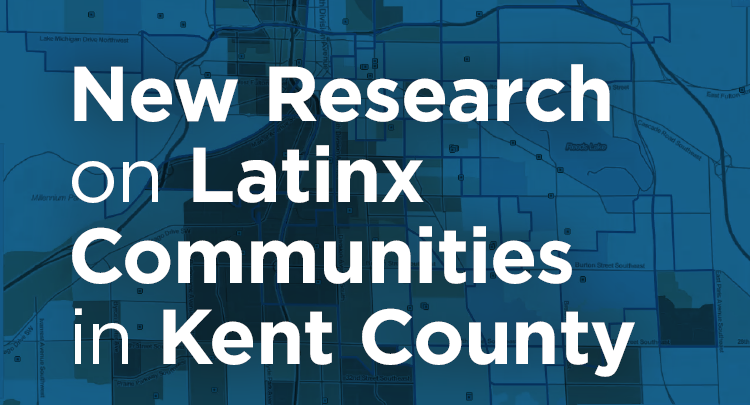New Report Illustrates the Status of Latinx Communities in Kent County, Mich.


 Inclusive growth is about ensuring prosperity for all. It’s about decreasing inequities and creating pathways to economic success for all residents in a community.
Inclusive growth is about ensuring prosperity for all. It’s about decreasing inequities and creating pathways to economic success for all residents in a community.
To bring these inequities to light, we need to look at data that are disaggregated (i.e., broken down) by race and ethnicity. Looking at overall population numbers is not enough. Averages frequently don’t tell the whole story — in fact, they often obscure the different realities that people in the same community experience. Disaggregated data, on the other hand, can help us understand where and why inequities exist and can help guide us toward more effective solutions to the problems we see in our communities.
The Johnson Center’s Latinx Data Report specifically details Latinx responses to the VoiceKent 2017 and VoiceGR 2016 surveys, and how those responses vary from other major racial groups. The purpose of the report is to understand Greater Grand Rapids’ Latinx residents’ perceptions and experiences on a variety of topics. The VoiceGR and VoiceKent surveys gathered information on topics such as housing, education, health, and food accessibility from residents in the greater Grand Rapids area and Kent County, Mich. respectively.
The VoiceKent 2017 survey results found that Latinx[1] respondents were about equally as likely as other racial/ethnic groups to have full-time and part-time jobs, yet they were more than twice as likely not to have health insurance. They were the least likely of all racial/ethnic groups, and only half as likely as white respondents, to say they felt “very safe” in their neighborhoods/communities.
To explore Key Findings from the entire VoiceKent 2017 report, click here.
After controlling for other factors including religious status, age, gender, sexual orientation, and educational attainment, the odds of rating one’s mental health as “Excellent” or “Good” were nearly 30% lower for Latinx respondents than white respondents. Examining the barriers to health care that Latinx residents said they face may help to explain this difference. Latinx respondents were three times as likely as other respondents to point to language as a barrier to receiving mental health care. Furthermore, about half of Latinx respondents mentioned cost as a barrier to both physical and mental health care.
Perhaps contributing to the cost barrier is that Latinx respondents were more likely than white respondents to have lower incomes. That’s not entirely due to a difference in levels of educational attainment. Across nearly all levels of educational attainment, Latinx respondents were more likely to have lower incomes than white respondents. Of those with a graduate degree or higher, 29% of Latinx respondents, compared to only 10% of white respondents, said their annual household income was less than $30,000.
On the same subject, Latinx respondents were less likely than white respondents to rank that they could meet their basic needs “very well” based on their current income. And in 2017, Latinx respondents were the least likely of all racial/ethnic groups to say their families have access to enough fruits and vegetables.
These kinds of disparities are often due to discrimination and unequal opportunities (Gamboa, 2019). As a community, this tells us we need to be doing more to provide economic and other opportunities for our Latinx residents. It tells us we need to move toward an economy that focuses on inclusive growth (Olivarez, 2019).
Grand Rapids and Kent County are expected to continue to racially diversify, with the Latinx population growing the fastest. PolicyLink & PERE (2017) examined demographic data for Kent County and projected that a quarter of the county’s residents will be Latinx by 2050. The vitality not only of the Latinx community but of our city and county as a whole will depend upon the intentional and purposeful inclusion of Latinx residents. Education, income, and health are all inextricably intertwined, and it is important that we address racial disparities across all of these areas and create equal opportunity for success across the board.
If you would like to dig further into the data, the VoiceKent and VoiceGR data are publicly accessible via the Tableau data visualization platform here. Our Community Profiles tools house publicly available data, such as American Community Survey (ACS) data, and can be found here.
_______________
[1]The term “Latinx” in this report refers to all respondents who selected the category “Hispanic or Latino/a” on VoiceKent 2017 or “Hispanic/Latino” on VoiceGR 2016 when asked about their race and/or ethnicity. The term white refers to respondents who selected white and did not also select the option “Hispanic or Latino/a” when asked about their race and/or ethnicity.

Gamboa, S. (2019, Feb. 26). Racism, not a lack of assimilation, is the real problem facing Latinos in America. NBC News. Retrieved from https://www.nbcnews.com/news/latino/racism-not-lack-assimilation-real-problem-facing-latinos-america-n974021
Olivarez, J. (2019). Inclusive growth communities: New strategies for prosperity [blog]. Dorothy A. Johnson Center for Philanthropy. Retrieved from https://johnsoncenter.org/inclusive-growth-communities/
PolicyLink & PERE. (2017). An equity profile of Grand Rapids. Retrieved from https://www.policylink.org/sites/default/files/GrandRapids_final_profile.pdf